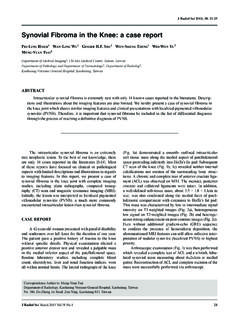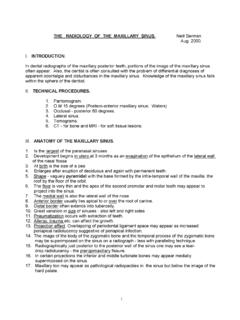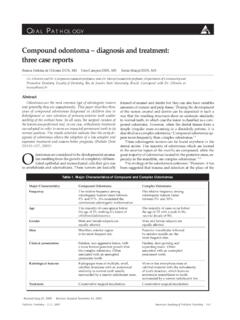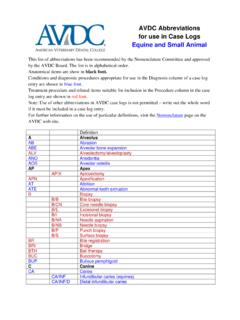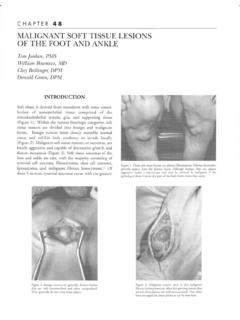Transcription of RADIOLOGY OF CYSTS OF THE JAWS - Columbia …
1 1. IMAGING OF CYSTS OF THE JAWS. April 1999. N. Serman This is an area where RADIOLOGY plays an important role in assisting with the diagnosis, determining the size of the lesion and the relationship to adjacent structure. CYSTS occur more commonly in the jaws than in any other bone. Definition: A cyst is an epithelial lined, pathological cavity having fluid, semi-fluid or gaseous contents: and surrounded by connective tissue. TECHNICAL ASPECTS. 1. Occlusal view 2. Pan 3. PA, OM, lateral oblique 4. CT - for bony lesions. 5. MRI - for soft tissue lesions ETIOLOGY. Developmental Inflammatory Traumatic Neoplastic As the cyst enlarges it is more likely to cause cortical expansion ( and thinning) but the margins tend to remain intact.
2 Numerous classifications have been published of CYSTS of the jaws and most of them are satisfactory. CLASSIFICATION. N = asked on NERB. B = asked on Nat Boards I. BONE. A. EPITHELIAL. 1. Developmental a. Odontogenic i. Dentigerous (follicular) B. N. ii. Eruption N. iii. Lateral periodontal B. N. Gingival cyst of adult N. iv. Keratocyst (primordial) v. Calcifying Odontogenic vi. Gingival cyst of newborn b. Non Odontogenic. i. Nasopalatine duct cyst cyst of incisive papilla B. 1. 2. ii. Globulomaxillary ? ? iii. Median palatine. (mandibular). 2. Inflammatory i. Radicular B. N. ii. Residual. B. N. iii. Paradental iv. Collateral B. N. B. NON-EPITHELIAL. i. Latent bone cyst / lingual mandibular salivary gland depression (defect) / Stafne cyst ii.
3 Simple/unicameral / traumatic/ hemorrhagic iii. Aneurysmal bone cyst iv. Mucosal cyst of maxillary antrum v. Extravacation cyst and ranula B. C. GORLIN GOLTZ / Basal cell nevus syndrome II. SOFT TISSUE. i. Nasolabial N. B. ii. Dermoid N. B. iii. Thyroglossal N. iv. Branchial cleft N. [Also called Lympho-epithelial]. A. EPITHELIAL. 1. Developmental Clinically, CYSTS may achieve extreme size before they are discovered clinically; especially true in the mandible. A. ODONTOGENIC CYSTS . I. DENTIGEROUS cyst . A follicular cyst , or dentigerous cyst is a developmental odontogenic cyst which develops around the fully-formed crown of an unerupted tooth. Most are discovered on routine radiographs, when a tooth has failed to erupt, a tooth is missing, teeth are tilted or are otherwise out of alignment.
4 The dentigerous cyst is most frequently found in the age group 20 - 40 years. The most prevalent areas for dentigerous CYSTS are, in order of frequency, the mandibular third molar, maxillary third molar, maxillary canine and mandibular second premolar. teeth that are prone to impaction. About 75%. are located in the mandible. This is the most common pericoronal cyst Radiographically. There is no sharp borderline between a normal enlarged pericoronal space and a cyst ; if the width of this space has reached more than 2. 3. mm [and has an irregular outline] it is probably a dentigerous cyst . Dentigerous CYSTS may be classified according to the site at which the cyst develops in relation to the crown of the tooth.
5 It may be of the central or lateral type. Impacted supernumerary teeth often develop dentigerous CYSTS . Dentigerous CYSTS have a greater tendency than other jaw CYSTS to produce root resorption of adjacent teeth they are the most aggressive of the CYSTS . Found after the age at which the tooth should have erupted. In younger patients consider a differential diagnosis of ameloblastic fibroma. ii ERUPTION cyst . Is a variation of a dentigerous cyst and occurs partly in the soft tissue. The eruption cyst may impede a tooth in its eruption within soft tissues overlying the bone. The eruption cyst produces a smooth, fluctuant swelling over the erupting tooth which may be either the color of normal gingiva, or pale blue.
6 It is usually painless unless infected. Radiographically - The cyst may throw a soft-tissue peri-coronal shadow, but there is little bone involvement except that the dilated and open tooth crypt around the unerupted crown, may be seen on the radiograph. iii LATERAL PERIODONTAL cyst / GINGIVAL cyst OF ADULT. Lateral periodontal CYSTS occur most frequently in the mandibular canine-premolar area in young adults . They are usually symptomless and are discovered during routine radiological examination of the teeth. Radiographically - shows a well-defined, unilocular, round or avoid lucent area. The cyst lies somewhere between the apex and the cervical margin of vital teeth. They vary in size from as small as 1 mm to larger lesions which may involve the length of the root.
7 The Botyroid cyst is a multilocular variation iv. ODONTOGENIC KERATOCYST and (PRIMORDIAL cyst ). Keratocyst or primordial is a cyst with keratinized epithelium. A primordial cyst forms from the tooth bud and forms instead of a tooth. All primordial CYSTS are keratocysts but all keratocysts are NOT. primordial CYSTS . The keratocyst arises directly from the dental lamina or remnants thereof. Often contains cheesy material that is produced by the epithelium. Some investigators use the non- committal term odontogenic keratocyst regarding the pathogenesis and only state that the cyst lining is keratinized. Keratocysts have characteristic locations, the ramus of the mandible, the canine region in the maxilla and mandible, and the mandibular third molar region.
8 In many instances, patients are free of symptoms until the CYSTS have reached a large size. 3. 4. Patients may complain of either pain, swelling or discharge. The primordial cyst tends to extend in the medullary cavity and expansion of the cortex occurs late. The enlarging cyst may produce displacement of the teeth Radiographically. Primordial CYSTS may appear as unilocular, round or avoid radiolucent areas. Often the lesions are extensive. Most are well demarcated with a distinct sclerotic margins as expected from a slowly enlarging lesion. If multilocular, the locules are well demarcated and may be misinterpreted as an ameloblastoma. The scalloped margins suggest that unequal growth activity may be taking place in different parts of the cyst .
9 Primordial CYSTS may impede the eruption of adjacent teeth and this results in a "dentigerous" appearance radiologically. The mandibular canal is often displaced and highlighted. Keratocysts have a pronounced tendency to recur. Most common distal to the canine tooth. Primordial CYSTS forms in place of a tooth; most commonly found in the mandibular third molar region. v. CALCIFYING ODONTOGENIC (EPITHELIAL) cyst - GORLIN. The calcifying odontogenic cyst has many features of an odontogenic cyst and tumor - epithelial proliferation and continuous growth. It originates from developmental odontogenic epithelial tissue. The lesion usually occurs as a slowly enlarging, frequently painless and non-tender swelling of the jaw.
10 Intra- osseous lesions may produce a bony expansion and may be fairly extensive. Often associated with en unerupted tooth. Affects females under 40 and males over age 40. Radiographically The lesion appears as a well defined, uni- or multilocular radiolucent, cystic area. Initially there are no calcifications and thus appears as a non-specific cyst . Later, small irregular calcified [opaque] bodies may be seen in the radiolucent area and in some cases the calcification may be substantial and occupy the greater part of the lesion. This is the only cystic lesion with opacities. Differential Diagnosis partially calcified odontoma, adenomatoid odontogenic tumor, ossifying fibroma; ameloblastic fibro-odontoma, calcifying epithelial odontogenic tumor.










